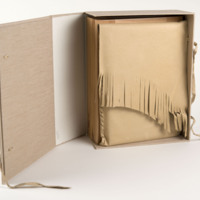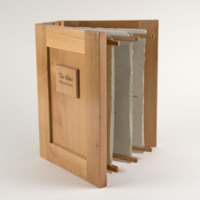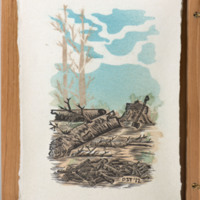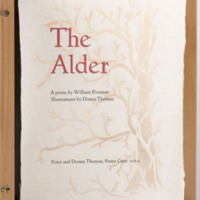A148. The Alder
A148. William Everson. The Alder. Santa Cruz, California: Peter & Donna Thomas, 2012.
A. Standard copies. 32 x 21 cm (12 ½” x 8 ¼”), 18 pages, 20 copies.
Binding: Modified Coptic binding; folio pages and pamphlet are stitched to an accordion spine which is Coptic sewn through the valley folds to covers. Covers are alder wood boards. Title laser cut into cover. End sheets brown. Housed in a fringed leather satchel. Paper: White, handmade by Peter Thomas. Printing: Letterpress; essay, artists’ notes, and initials on title page printed from polymer plates. Typography: Poem is hand set 18 pt. and digital 14 pt. Goudy Newstyle. Titles in red. Pamphlet is digital Goudy Newstyle. Illustration: Three linocuts and six paper pochoir prints, all by Donna Thomas. Notes: The single book of the standard copies includes the text and illustrations from both The Alder and A Companion to The Alder as included in the special copies.
B. Special copies.
The Alder: 33 x 28 x 10 cm (13” x 11” x 4”), 6 pages;
A Companion to The Alder: 32 x 21 cm (12 ½” x 8 ¼”), 12 pages, 30 copies.
Binding: The Alder is a unique structural binding; three alder wood frames (each consisting of an oblong alder wood block with two perpendicular wooden arms) are held between alder wood covers by barrel hinges. Title laser cut in alder wood block on cover. Pages stitched to arms of frames with thread. A Companion to The Alder is a modified Coptic binding; folio pages and pamphlet are stitched to an accordion spine which is Coptic sewn through the valley folds to covers. Covers are alder wood boards. Title laser cut into cover. End sheets brown. Housed in a fringed leather satchel. Both volumes housed in a drop-down clamshell box covered in beige cloth and secured with leather ties. Title on label on spine. Paper: White, handmade by Peter Thomas. Printing: Letterpress. Typography: The text of The Alder is hand set 18 pt. Goudy Newstyle. Title is digital Goudy Newstyle. Title in red. A Companion to The Alder is digital Goudy Newstyle printed from polymer plates. Title in red. Illustration: The Alder has one linocut and six pulp sprayed through stencil prints, all by Donna Thomas. A Companion to The Alder has two linocuts by Donna Thomas. Notes: The binding for The Alder was created by Peter and Donna Thomas. They have provisionally called it the “frame-as-page” binding.
“When William Everson produced the 1975 Lime Kiln Press edition of Robinson Jeffers’ Granite and Cypress he took fine printing to a new level. That book, with its edificial binding, ghost printing, and Everson’s signature on the colophon as artist rather than author, demonstrated that a book has the capacity to embody artistic as well as literary ideals. Granite and Cypress was the first of a new genre of art: the fine press artists’ book. When we conceived the idea to make an artists’ book using Everson’s poem ‘The Alder’ as the text, we decided to refer conceptually, in a number of different ways, to Everson’s masterpiece, Granite and Cypress.
As we have come to understand Everson’s poem through the process of creating this book, the poem's alder tree represented for Everson his own lost potential. In the poem the poet fells an old and stately tree, but only to use it as firewood. Everson was at the height of his career when he was working on this poem, and had recently been diagnosed with Parkinson’s disease. Like the alder, he was cut down in his prime, no longer able to create the work he previously thought possible. Shortly before he died, Everson confided to me his dream that his library, and the A-frame building he had built with his own hands, would become a literary shrine, a place of pilgrimage, like Jeffers’s Tor House. Everson died penniless. That A-frame library had been built on rented land owned by benevolent landlords, but it was not his own, and on his death passed to new tenants. Symbolically, we made our book using tiny pieces of alder wood to represent the firewood fate of the alder in the poem. Rather than destroying, burning, those small bits, we built the binding for this poem using them. This book became a way we could fulfill Everson’s dream of creating a literary shrine for his words. This book is that literary shrine, a monument to his work and his life.
Everson’s greatest works of fine press printing all used Goudy Newstyle type. Everson claimed it ‘had a certain magic.’ We used Everson’s own Goudy Newstyle, the same type he used for Granite and Cypress, to print our book. We were able to print the book using the same ink Everson used, Mandlick Dull Strong Black ink, as I had a can that I bought when working with him at University of California Santa Cruz’s Lime Kiln Press. We made the paper for The Alder, and explored a new papermaking technique for this book, creating the background colors for Donna’s linoleum cuts and the shaded background images behind the poem by spraying colored paper pulp through multiple hand-cut stencils onto each newly formed wet sheet of paper. At that time we called the process ‘paper pulp pochoir’, but later, realizing the technique was more akin to airbrush painting, we began to refer to it as 'spraying finely beaten paper pulp through stencils.’ We first developed the binding we used for this book, what we call a ‘frame-as-page binding,’ in 2000 for Three Kinds of Magic [C6], and had always hoped to find a suitable project for it. Everson’s poem provided the perfect opportunity.”



